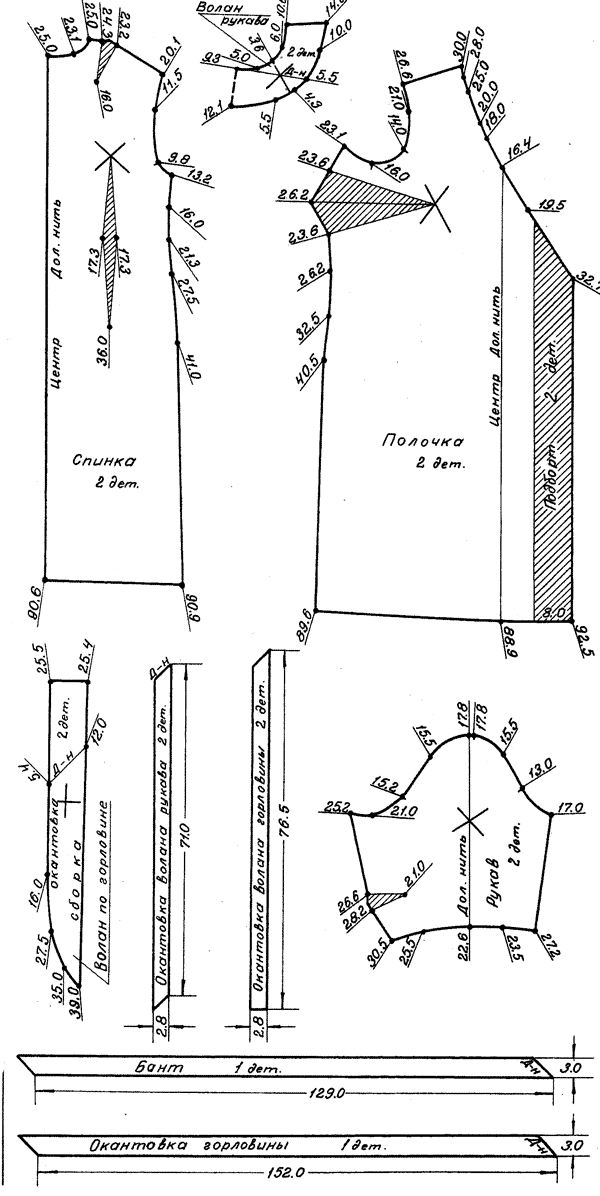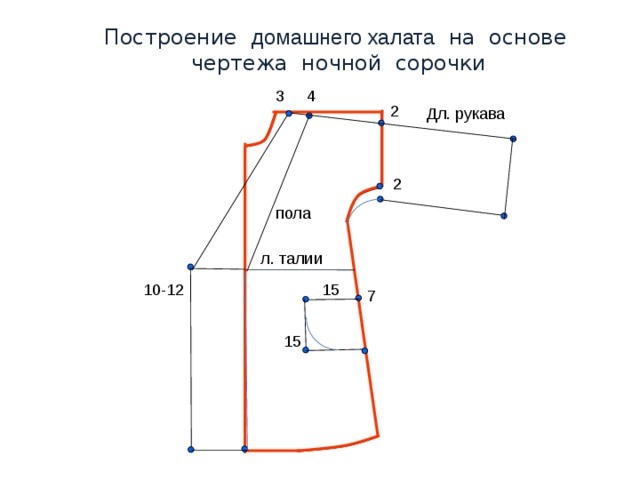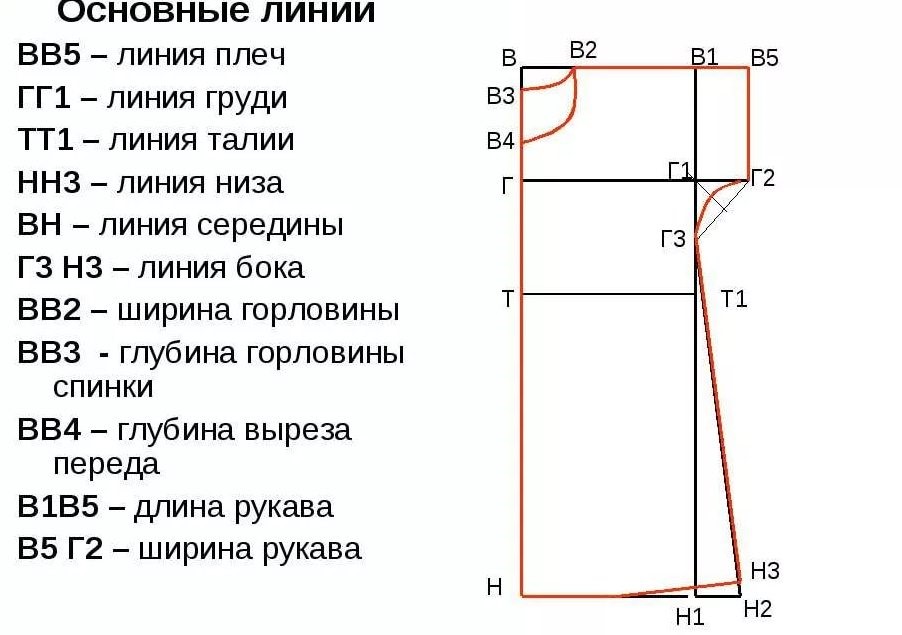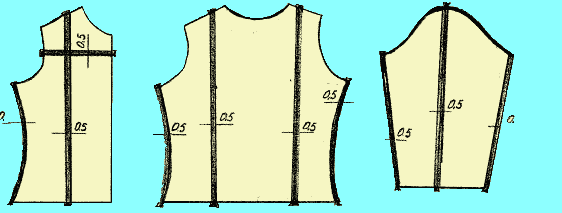 The robe is strongly associated with such concepts as bath, sauna, steam, relaxation, getting ready for bed. This is a comfortable outfit for an evening out. It’s not difficult to make, and models with a wrap will even save us from the need to sew loops. Let's look at simple patterns for women's dressing gowns for beginners.
The robe is strongly associated with such concepts as bath, sauna, steam, relaxation, getting ready for bed. This is a comfortable outfit for an evening out. It’s not difficult to make, and models with a wrap will even save us from the need to sew loops. Let's look at simple patterns for women's dressing gowns for beginners.
Principles for constructing a wraparound robe pattern
The most difficult thing is choosing patterns for girls, who needs sizes larger than fifty. Therefore, we will consider large sizes and how to increase or decrease the base pattern.

Pattern-basis of a robe with a wrap
An excellent solution for them would be to create a base pattern, which can be used to sew almost any product. By changing the length of the product, moving the dart to the neck line, waist, and so on, we get any item of clothing.
Taking measurements

To create a pattern we need the following measurements:
- Neck circumference (Osh)
- Chest circumference (Og).
- Hip circumference (About).
- Waist circumference (From).
- Shoulder circumference. (Op).
- Sleeve length (Dr).
- Dress length (Di).
- Back width (Ws).
Fabric calculation

When calculating the material, keep in mind that products with a smell imply stitched or one-piece selections.
Accordingly, the fabric consumption will be greater than for a dress with a front seam, sewn using the same pattern.

Cutting fabric
We need fabric in quantity: 2 product lengths + sleeve lengths.
How to make a robe pattern with your own hands?
A simple way to create a pattern for non-fitting items. From the shirt we get a drawing of a robe.
Step - build the outline of the shirt.
- We measure all the dimensions necessary for the drawing.
- Carefully transfer them to a sheet of whatman paper or wallpaper.
- Please note that the lines of the front and back are almost the same, but the lines of the neck are different.
 Step - modify the drawing.
Step - modify the drawing.
- Shift the shoulder line down 1-2 cm.
- Same with the underside of the shoulder.
- Extend the sleeve as needed.
- We shift the line of the neck of the shelf by 3 cm.
- We increase the width of the shelf for the smell.
- Please note that only the sleeve line changes at the back!
- Draw out a pocket of the desired shape.
- The pattern of the robe with one-piece sleeves is finished.
 Details: Shelf – 2 pcs., back 1 pc. with fold, pocket 2 pcs.
Details: Shelf – 2 pcs., back 1 pc. with fold, pocket 2 pcs.
Wraparound robe (size 54)
Required:
- Terry or corduroy fabric, thick knitwear - 3.5 meters.
- Threads to match.
- Adhesive padding for belt and collar optional.
- A scrap of fabric for the burlap pockets is optional.
 It is better to make the collar double. To do this, circle it onto a separate part.
It is better to make the collar double. To do this, circle it onto a separate part.
Progress:
- We lay out the patterns on the prepared fabric, chalk it, and do not forget about the allowances. Don't forget to cut out the pocket details separately.
- Cut it out.
- We sew the darts.
- We sew the shoulder seams, preferably with a backstitch.
- Sew the side seams of the sleeves.
- Sew the sleeves into the open armhole.
- We sew the burlap pockets to the shelves.
- Sew the side seams.
- We sew the collar piece to the one-piece collar. First, we trim its sections with trim.
- We process all cuts with binding.
- Fold the bottom of the robe, seam it at a distance of about 3 cm.
- Sew the belt as desired.
- Ironing.
 Other models of dressing gowns are made in the same way.
Other models of dressing gowns are made in the same way.
Enlarging the pattern
Most magazines and websites do not offer a very wide range of sizes. Successful patterns in sizes 56, 58, 60 are almost never found.
But There are simple ways to increase the pattern by a couple of sizes, especially since the robe always implies some freedom of fit.
Advice! The simpler the cut of the product, the more successful and unnoticeable the enlargement process will be.

How to enlarge a pattern?
Stages of work:
- We draw vertical lines along the front and back, sleeves, and horizontal lines along the chest.
- Let's cut it.
- Add 0.5 cm to each cut.
- Add 0.5 cm along the side of the parts.
- We outline the new boundaries of the patterns.
- Cut it out.
- Thus, we added 2 to 3 cm in volume.
- You can take fewer centimeters.

Reduce pattern
Advice! Similarly, you can reduce the pattern; to do this, we move the parts on top of each other, reducing the volume.
A robe without a pattern made from a terry sheet

You can make a short bathrobe with a hood from an ordinary terry sheet. The value of the technique is that there are no scraps left, all the fabric is used.
The size of the terry robe model is limited by the volume of the hostess’s hips and the width of the sheet.

Terry towel robe
The drawing is given for a canvas 130 cm wide. Accordingly, to obtain the smell, the maximum size of the product that we can obtain is 50-52, hip volume 104 cm. If we take a double sheet, we can sew a larger model.
Progress:
- We mark the fabric according to the drawing.
- If we want to get a long product, then we need additional fabric for the bottom.
- We cut out the pieces of fabric highlighted in gray; these will be our pockets.
- We do not cut the line connecting the hood to the main part; the hood will be solid.
- We cut off the sections that will become the sleeves.
- We sew them into the armholes.
- Sew the shoulder seams and side seams of the sleeves.
- We sew the sides of the hood, hem its front side part along the neckline.
- We process the cuts with bias tape, braid, overlay or narrow zigzag stitch.
- Ironing.
- Let's try it on.

Wraparound robe with frill
As you can see, it’s easy to make a robe if you want, even if you have very little sewing skills.


 0
0





